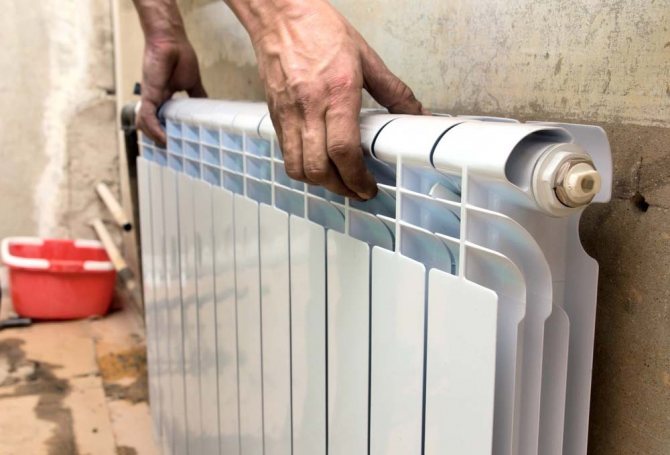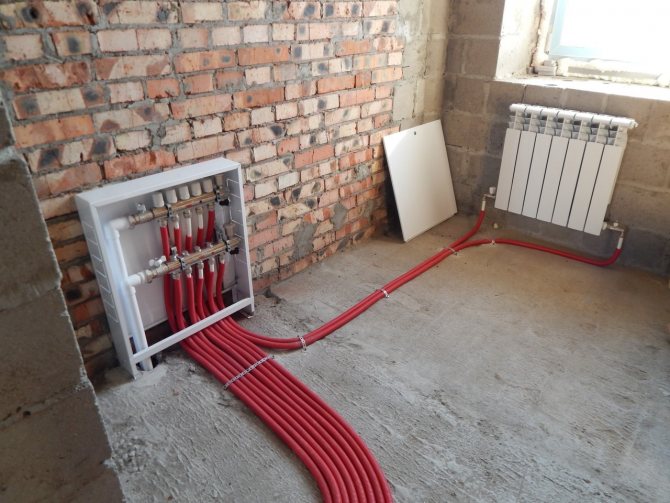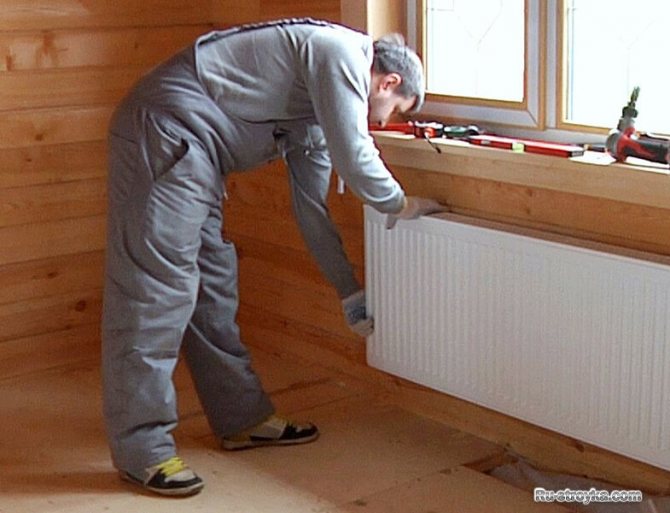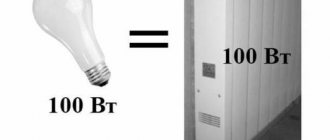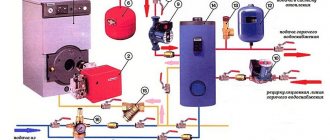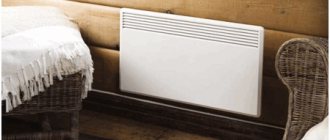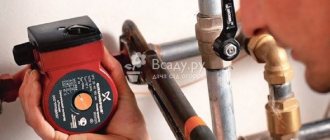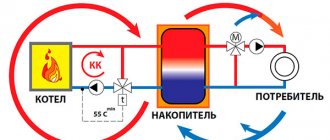If a construction project is just being developed, then it is easier to choose a suitable option for heating a house. Of course, you need to take into account the region, the availability of the most affordable fuel, the number of storeys of the house, the degree of insulation and some other factors that are specified after the thermal calculations. But choosing heating options for a private house of an existing one is a little more difficult. In this case, we are often talking about replacing outdated or unprofitable heating with another type of heating. In this case, the following types of heating systems for a private house and their popular options are possible:
- water heating using boilers on various fuels;
- gas or electric convectors;
- air heating;
- pipe heating without radiators.
Air heating used for heating is designed and installed during the construction of a house. The option is very expensive, and it is difficult to assemble it for existing premises. We will not delve into the consideration of expensive exotic systems and consider the available and popular types of heating for private homes.
Popular heating schemes
In the presence of a gas main, the gas heating scheme of a private house is the most optimal. In this scheme, a gas boiler is installed as a heat generator, which heats the coolant. The movement of the coolant occurs either under the action of gravity (gravity systems) or with the help of a circulation pump. For small private houses, heating schemes for a private house with a wall-mounted boiler are successfully used, if there is no separate room for a boiler room, and the dimensions of the kitchen are limited.
The piping layouts themselves are standard:
- one-pipe;
- two-pipe.
One-pipe scheme
A one-pipe system with a series connection of radiators is used only in small houses or summer cottages. This wiring diagram has a significant drawback - uneven heating of the batteries, which is especially felt if a heating circuit of a private house without a pump is installed, which is called "gravity". If the length of the circuit is small, then the circulation pump almost completely compensates for this disadvantage. With a large number of batteries and a significant length of the circuit, an upgraded one-pipe system - "Leningradka" is used. It was invented in Leningrad - present-day St. Petersburg.
Two-pipe scheme
The two-pipe scheme for connecting a gas boiler in a private house is the most optimal in terms of uniformity of heating even when using a "gravity system", but more material-intensive. In this scheme, the coolant enters the batteries through the supply pipe, and returns through another, which is called the "return". All heating devices are connected to these two pipes in parallel, which makes it easier to repair and adjust the temperature in different rooms.
Which pipes and radiator are better in the heating system of a private house?
It is not entirely clear from the wording of the question whether the private house is yours or belongs to the customer ...
If we assume that the house belongs to the customer of the work, then in order to avoid claims on his part, everything should be done in accordance with the project (contract).
If you equip your house with a heating system, then its elements should be chosen, taking into account the durability and ease of maintenance, of course, taking into account the "question price" available to you personally. Usually, everything works out when the work is performed according to a ready-made project that suits everyone.
Now in order. And so the pipes:
"... which pipes to choose: steel or ferrous metal?" There are only two types of ferrous metal - steel and cast iron.Cast iron differs from steel only in the percentage of carbon in the alloy and usually in the presence of certain alloying additions. Pipes for heat-water-gas supply systems earlier (in the last century) were produced only from steel of various grades. This was due to their relatively low cost and the ability to quickly install systems. However, the advantages of steel pipes ended there. The main disadvantage of steel pipes is their poor resistance to corrosion damage and, as a result, low durability. Therefore, if there is a desire to inherit a reliably working heating system, then I do not recommend using ferrous metal pipes.
Currently, polymer and metal-polymer pipes are manufactured for use in heat-water-gas supply systems. Their constructive difference is the reinforcing layer. Some use fiberglass, others use metal (usually aluminum).
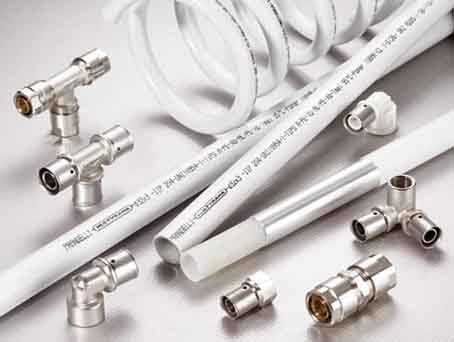
Their main advantage is the impossibility of utilizing the material in natural conditions. It is this quality that determines their extremely high resistance to corrosion damage. In addition, polymer pipes have many other advantages over steel pipes. When operating under passport conditions, the service life of polymer pipes is at least 50 years.
In accordance with current design standards, pipelines of all systems must be laid discreetly. Piping of engineering systems is not used in interior design. The pipelines of engineering systems are fixed on the elements of the supporting structures of buildings, in specially equipped channels, behind decorative lining. As a last resort, pipes are laid in special plastic boxes.


And now about: "which radiator is better to buy for a private house, the area of the house is about 60 square meters?"
Let me assume that you need a heating device in your house, not a source of thermal energy. If this is the case, then it is usually chosen according to two parameters - according to the required power and as an element of the interior of the room, naturally, based on financial capabilities. The power of a heating device for a "normal" living space made of stone-reinforced concrete structures with "standard" thermal insulation is selected at the rate of 1 kW per 10 square meters of area. But it is far from the fact that the temperature in the room after such a "selection" will be comfortable. Usually, one heating device is installed in each room. In rooms of large volumes and taking into account the requirements of space-planning solutions, several heating devices can be installed. If a decision is made to use radiators of standard designs as heating devices, then most likely they will need to be covered with decorative grilles, which will inevitably reduce their efficiency.
Today, in terms of design and technical characteristics, the most efficient heating device is a fan coil unit. None of the radiators can compare with it in terms of efficiency and heat transfer.
Fancoil units are currently produced in a fairly large number of models, significantly differing in a number of capacities and appearance. All of them easily and naturally fit into any interior.


That's basically everything about which pipes and radiator are better in the heating system of a private house ...
There will be questions - I will answer in personal correspondence. Good luck!
Heating system without radiator
There is, still rarely used due to the high price, pipe heating without radiators in a private house used in the reconstruction or construction of a house. The pipes of the underfloor heating contours are laid in the floors and filled with a screed.
To create a radiator-free system, an integrated manifold is installed, which is integral with the mixing unit.
In such a system, the temperature is automatically regulated and there is the possibility of remote control. There can be several distribution manifolds for each room. For small rooms - bath, toilet, etc., a compact pumping unit is used, for example, Thermotech MINI350 with a built-in 350 W heater. With the help of this device, warm floors are realized in small rooms. Such individual gas heating in a private house is extremely comfortable, but requires significant financial costs.
What is the best underfloor heating?
Today, there are two main types of underfloor heating - water and electric. The latter, in turn, is presented in three variations: rod, cable and film. Each has its own pros and cons.
The choice of a specific option directly depends on the conditions and the possibility of installation. Evaluating the main advantages of a warm floor, without taking into account its specific type, the following can be noted:
- livability of the system. In simple terms, a warm floor is able to maintain the most comfortable temperature in the room for staying in it. Unlike traditional heating systems, there will be no place for local overheating or barely warmed up areas;
- underfloor heating aesthetics. There are no visible elements of the heating system. Here it is not required to link it to the arrangement of furniture inside the room. You can enjoy a warm floor without radiators and get more free space for decorating your home;
- versatility. You can use any source of energy (electric or water heat-insulated floor), any type of heat carrier (in the case of a water-heated floor) and any floor covering;
- human safety and health. A significant advantage of a warm floor is the absence of dust circulation inside the room, which is a real salvation for people with allergies;
- profitability. Optimum temperature distribution can significantly reduce heating costs. Unlike traditional heating systems, underfloor heating does not heat the space above the ceiling, but the floor and the surface above it. Therefore, all rooms will have very comfortable conditions.
We recommend: How to make a warm floor?
Which pipes are better
A scheme was chosen, a boiler was purchased and inevitably a decision must be made - which pipes to choose for heating a private house, plastic or metal. Pipes can be made of any material, but for heating, either metal or polypropylene reinforced pipes are most often used. Metal and plastic pipes have advantages and disadvantages.
Metal pipes
With the help of metal pipes, all equipment for gas heating of a private house is combined - a boiler, radiators, an expansion tank, etc. Steel pipes are durable, but welding is required for installation. Sometimes owners use threaded connections, but this is a very time consuming method. Metal pipes are susceptible to corrosion and a sediment gradually accumulates inside, consisting of rust and various contaminants.
But they also have undeniable advantages:
- high rigidity, which allows you to install any slope with a minimum of fasteners;
- slight linear expansion;
- resistance to high temperatures, pressure and water hammer;
Reinforced-plastic pipes
Reinforced-plastic pipes are made of polyethylene. They consist of three layers. The middle layer is made of aluminum and all three layers are firmly glued. Aluminum increases rigidity and reduces linear expansion of the pipe. The disadvantage is the high cost. To prevent leaks during operation, you need to use high-quality metal fittings.
Polypropylene pipes
It is recommended to use only reinforced polypropylene pipes for heating. For installation, you need a special welding machine and fittings.
Floor standing boilers
With floor heating boilers, the situation is somewhat more complicated. They have only two pipes: supply at the top, "return" at the bottom, they are not equipped with a safety group and a circulation pump.
Supply piping tips:
- buy a branded security group in specialized stores;
- remember, there should be no shut-off valves between the boiler and the safety group;
- be sure to install an emergency valve. From it, lead the pipe into some container so that the water does not pour out onto the floor.
- Shut-off valves, branches and tees can only be installed after an emergency group.
To strap the coolant return line, it is necessary to assemble the strapping of the parts in the following sequence:
- T-piece for removing water from the boiler, if there is no such drain in the boiler itself.
- A shut-off valve with a union nut is needed so that the system is collapsible and suitable for repair.
- Circulation pump.
- Mud filter.
- Stopcock.
- Tee.
- Expansion tank "expansomat".
Advice:
- When selecting a circulation pump for household use, buy: Grundfos UPS 25/40 or 25/60. In a private house with an area of up to 300 m2, it is enough to purchase a UPS 25/40 pump.
- Pay attention to the "return" outlet from the boiler. It can come out to the left, right or behind the case. Accordingly, the return line in each case can have a direction to the right or to the left. It may happen that the terminal box of the circulation pump is directed downwards and it is difficult to access it. This problem can be easily solved. Unscrew the 4 screws on the pump casing and turn it to the desired position.
- The expansomat is needed to take over pressure fluctuations in the heating system. Its volume should be approximately 0.1 of the volume of the heating system. It is connected to a tee installed after the mud filter and a shut-off valve.
- A pipeline is connected to the same tee to fill the system.
We make piping of heating radiators with our own hands
Heating batteries can be tied in three ways:
- "Leningradka" for one-pipe systems;
- one-way connection on the left or right for short radiators;
- diagonal connection of long batteries;
There are three types of shut-off valves on radiators:
- Ball Valves;
- manual valves;
- pressure-operated taps for temperature control.
Attention.
- Valves with push-action thermal heads are installed only in systems with automatic control. It is strictly forbidden to install taps to adjust the temperature in radiator batteries on solid fuel, liquid fuel boilers without automation!
- If, after filling the system and a test run, only half of the battery heats up, it is necessary to release air from it through the Mayevsky valve. It is located at the end and is unscrewed with an ordinary screwdriver.
Boilers for individual heating
Any gas heating system of a private house involves the installation of a boiler, which uses gas to heat the coolant. If there is no natural gas, the heating circuit will provide a propane gas boiler with a hot coolant, which is pumped into cylinders in a liquefied form. The products of the world's largest manufacturer of gas equipment, the Japanese corporation "Rinnai", have appeared on the market.
The unique Rinnai gas boilers are created using the most modern technologies. These wall-mounted turbocharged double-circuit boilers with an efficiency of 96% operate at low gas pressure, and the combustion process itself is electronically controlled according to a special algorithm.
Boiler manufacturer Arderia Daesung Inductry co. LTD in South Korea produces a gas boiler Arderia, its price in rubles depends on the dollar exchange rate and is approximately 570 - 580 USD. The boiler is double-circuit, turbocharged, efficiency - 91.1%.The company produces single-circuit and double-circuit gas boilers, the difference of which is that a double-circuit boiler will provide the consumer with hot water.
Selection of heat generators and radiators
Heating boilers are:
- gas;
- electrical;
- solid fuel (firewood, coal, pellets);
- on liquid fuel (diesel oil, fuel oil).
Gas and electric boilers may be installed and connected only by specialized organizations. On solid and liquid fuels, heat generators can be installed independently. In order not to redo everything after installation, in the first case, you need to order a project.
The boiler is selected according to the area of a private house with a margin of 25-30% according to a simple formula, heating 1 m2 is equal to one kilowatt. In a house with a living area of 100 m2, you need to buy a boiler with a capacity of 12-13 kW, regardless of the type of fuel.
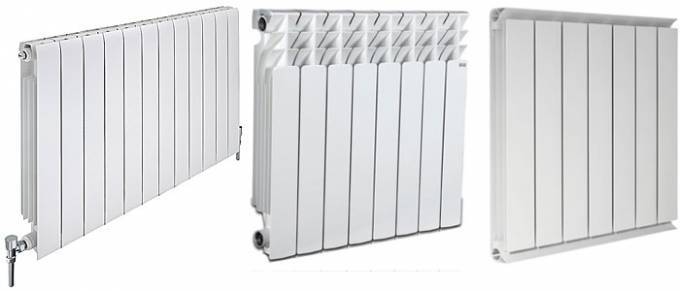

Household electrical networks are designed for loads up to 3 kW. For an electric boiler with a capacity of 10-13 kW, a separate line must be laid.
Electric boilers for heating
The boiler of any system is a heat generator; it heats the coolant and supplies it to the circuit. In principle, any heating scheme can work with any type of boiler.
Electric boilers for household heating are considered very convenient, but they require a sufficient power supply.
The mains supply to the boiler is usually done separately, with a cable with a cross-section of wires ensuring reliability and safety. The well-known German company VAILLANT produces not only high-quality gas boilers, but also electric boilers of the same name of various capacities. For example, wall-mounted, single-circuit from 560 cu. its price the Vilant boiler is produced with various capacities.
Advantages of installing electric boilers for private houses:
- Simple installation of heating boilers, much easier than gas boilers. Installation does not require a separate room.
- No chimney or separate room needed. The electric boiler can be located in any room.
- Small in size and weight, therefore, they are easy to fix.
- Environmental safety, no harmful gases are emitted.
- High efficiency - 95-98%.
Things to remember when using underfloor heating as the main heating system
- Where bedside tables, wardrobes or beds are installed, the warm floor will not heat the air in the room, but the furniture itself. When calculating, it is important to calculate not the total area, but the area that will be occupied by furniture;
- Underfloor heating has a lot of inertia. The screed really cools down for a long time, but it also heats up for a long time. Turn on the heating for several hours a day, wanting to maintain a stable and comfortable temperature inside the room every day, it will definitely not work;
- The underfloor heating system, regardless of its type, cannot guarantee high efficiency in rooms with a large area. Its efficiency decreases even more when it comes to large windows;
- The warm floor cannot be used to heat the vestibule. This room does not always end up in the zone of the main walls. If the outer walls are frozen, condensation will not form, but frost will appear very easily. You need to understand that it is simply impossible to exclude the flow of warm air from the heated room into the cold vestibule;
- May be uncomfortable in terms of temperature. The surface temperature of the warm floor is about 27-28 degrees. In this case, the legs will be as comfortable as possible. Taking into account the temperature drop, in this case the room will be 1-2 degrees less, and this is already a high enough temperature for the human body, at which it can be uncomfortable. Lowering the temperature of the warm floor, it may become uncomfortable for the legs;
- It is impossible to organize a water-heated floor from central heating.
We recommend: What is included in the Valtek underfloor heating kit?
Hood in a private house
For wall-mounted gas boilers that are equipped with an open combustion chamber, air enters the chamber from the room. Therefore, such devices require the equipment of an effective ventilation system. For safety, the kitchen in a private house with a gas boiler must be equipped with an extractor hood. Air circulation in the hood can be natural or forced. For forced extraction, a special fan is installed.
The installed hood for a gas boiler in a private house creates good air exchange and timely removal of harmful fumes.
If the boiler is wall-mounted, then the hood has a wall-mounted location, and for floor-standing boilers it is located near the floor. The diameter of the exhaust pipe must match the size of the boiler outlet pipe. The connection between the flue pipe and the hood must be tight and reliable. The top edge of the chimney must be above the roof ridge. A ventilation duct runs parallel to the chimney.
The nuances of using different types of batteries
Option 1. Steel
This is the most economical option for arranging a heating system.
Steel radiators for heating a country house are divided into two large categories:
- Panel... They are distinguished by excellent heat transfer coefficient, small size and attractive appearance. They can be used in systems with different piping connections: side, bottom, and so on.
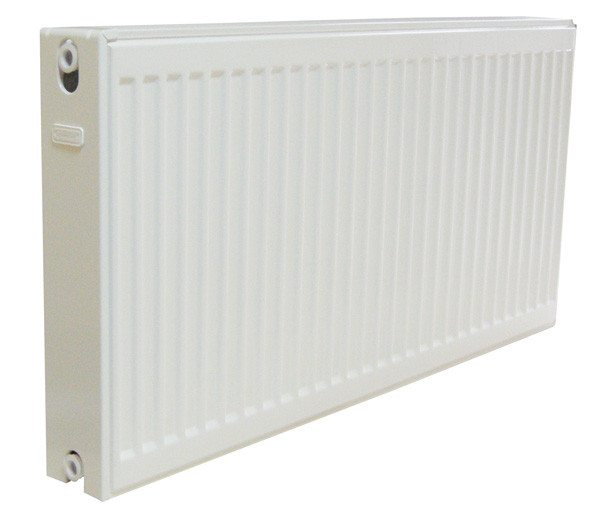

Steel panel radiator
Steel radiators are suitable for installation under the windowsills of large windows, as they create a dense thermal curtain that prevents cold air from entering the room and the formation of drafts.
- Tubular... Their price is slightly higher than the previous version. In addition, they are sold ready-made, and not in sections, so it will not work to assemble a battery of the required power. It is necessary to immediately purchase a product of a certain size.
Tubular radiators have great power, are attractive in appearance and can be used for drying various things. A striking example of such a device is a heated towel rail, which is available in every bathroom.
The main advantages of steel heating elements are as follows:
- low cost with a very high efficiency;
- slight oxidation from a coolant contaminated with chemical impurities and debris;
- long time of operation;
- lightness and compactness - they can be easily installed by hand, brackets that come with the device are used for fastening.
Steel tubular radiator
However, the considered devices also have some disadvantages:
- the design of these batteries is not bad, but not always suitable for a certain room interior, which does not allow them to be used as an element of room decoration;
- require maintenance - steel batteries should be flushed at least twice a year, otherwise the channels may be clogged with mineral deposits;
- steel radiators must always be filled with a coolant (even if the heating system is not in use), otherwise the inner surface of the panels will fill with rust and become impenetrable for liquid.
Option 2. Aluminum
Radiator heating of a country house using aluminum batteries is also widespread. This is due to the innovative design of these products and their high power. Their cost is not much higher than steel models and depends on the manufacturing plant.
Advice! The price of aluminum panels from Russian manufacturers is lower than that of foreign counterparts, and they practically do not differ from each other in quality. Therefore, if the issue of saving is important to you, pay attention to domestic models.
When installing and operating such heating radiators, the following instructions must be observed:
- Aluminum is very sensitive to the composition of the fluid used as a heat transfer medium. Especially the acidity level. Failure to comply with this requirement may damage the battery within 2-3 years due to rapid corrosion.
- When designing a system, the power of the devices must be calculated very carefully. If you install a battery that is too large, the air will warm up and rise to the ceiling too quickly, as a result of which local cold zones form near the floor, which does not contribute to the comfort of people there.
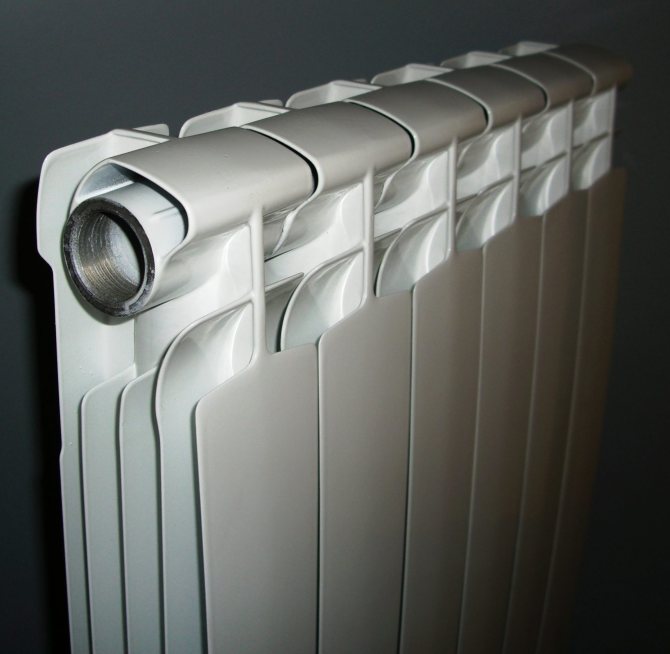

Aluminum heating battery
You can safely install aluminum heating radiators in a private house. Subject to the rules of installation and operation, they will serve as a source of comfortable heat for many years.
Option 3. Bimetallic
Bimetallic radiators are the most modern, economical, environmentally friendly and aesthetic way of heating premises using a liquid heat carrier. They embody all the advantages of powerful aluminum devices and reliable steel structures.
Their structure is simple. Inside the aluminum heat exchanger, which effectively heats the air in the room, there are steel tubes that circulate the coolant and protect the non-ferrous metal from the destructive effects of aggressive chemicals dissolved in water.
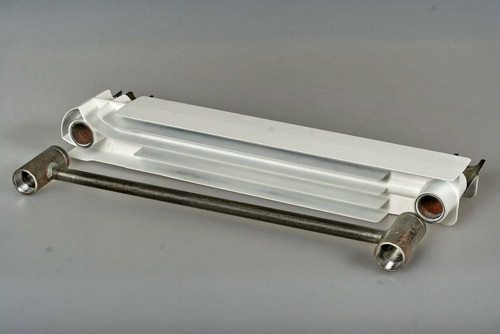

Bimetallic heating radiator device
The advantages of this solution are obvious:
- long service life of radiators - according to manufacturers, they can last for 40 years or more;
- the ability to withstand high pressure - steel pipes can transport a coolant under a pressure of 30-35 atmospheres without the use of any additional equipment;
- attractive appearance - the aluminum heat exchanger has a smooth surface and is covered with a high-strength decorative layer that perfectly tolerates physical impact and is easy to clean with ordinary household detergents.
However, all of these advantages come at a price. The cost of bimetallic radiators is very high; not everyone can afford to purchase such equipment.
Note! There are cheaper varieties of "bimetallic radiators", which, in fact, are not. In them, only a part of the channels through which the coolant flows is reinforced with steel pipes. Therefore, they do not have one of the main advantages of these devices - corrosion protection, which makes their use absolutely impractical.
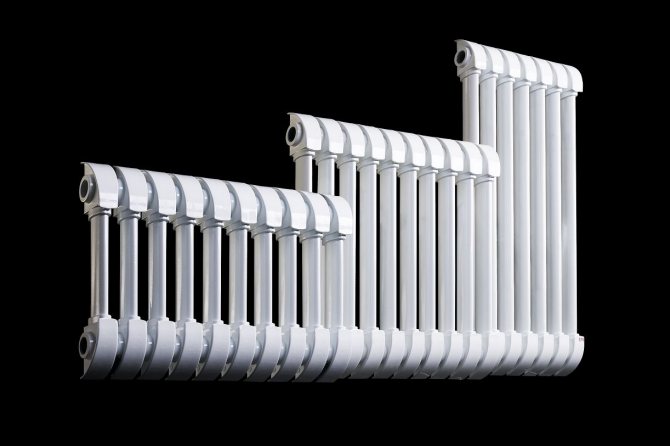

Externally, a bimetallic battery cannot be distinguished from an aluminum one
Most of the negative factors that bimetallic batteries protect against can be avoided with the correct design, construction and operation of the heating system. Therefore, you should not spend money on the purchase of such devices, consider other of the options given in this article.
Option 4. Cast iron
The history of cast iron batteries goes back over 100 years. Such radiators are widely used to design both centralized heating networks and self-assembled self-assembled systems.
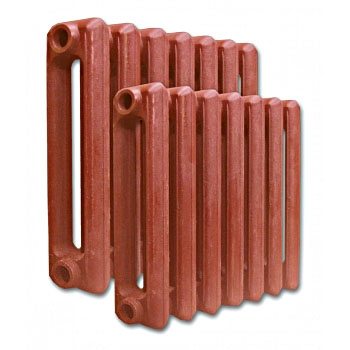

Cast iron radiator - a classic of HVAC equipment
Let's dwell in more detail on the features of cast iron radiators:
- This material heats up and cools slowly... Therefore, in case of short breakdowns in the heating system, the batteries will continue to heat the room. However, the same feature does not allow fine adjustment of the parameters of the equipment using automatic thermostats.
- Cast iron is corrosion resistant... This parameter, which is so important for a city apartment, in a private house loses its relevance, since here it is possible to control the quality of the coolant and get rid of harmful impurities in it.
- You can purchase design options for cast iron batteries, which will serve not only as heating equipment, but also as a fashion accessory that complements or emphasizes certain interior solutions.
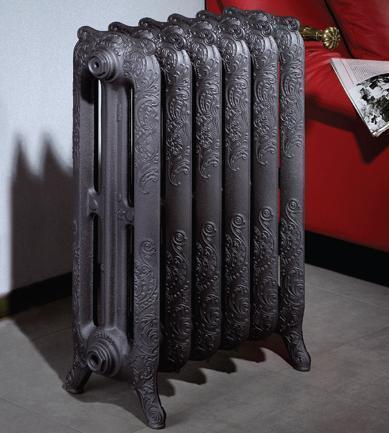

This work of art is also a heating radiator
One of the important factors to consider is cost. The price of cast iron batteries is higher than steel and aluminum, but much lower than bimetallic ones. Therefore, as in the previous case, it is recommended to prefer other, more economical and efficient options to cast iron batteries.
Heating batteries in a private house
All known types of batteries are used for autonomous heating. The use of one or another type of radiator is determined by the requirements for the design of the room and largely depends on financial capabilities.
The batteries, if you arrange them in order of increasing price, will be arranged like this:
- cast iron batteries;
- steel batteries;
- aluminum batteries;
- bimetallic batteries.
For summer cottages and country houses, if no one constantly lives in them, it is imperative to drain the coolant to avoid defrosting the system. This circumstance limits the use of steel batteries, which, in the absence of water, will actively corrode.
Each owner should know which heating batteries are best for a country house or summer cottage. You can install any, but taking into account the shortcomings of steel batteries. If the owner constantly lives in a country house, then he can install radiators that suit him in price and design.
Which floor heating to choose?
Much depends on various parameters and conditions. For example, the area of the room, as well as its location, is of particular importance.
If we are talking about a private house, then here you can consider any type of underfloor heating, but it is still better to preliminarily assess the feasibility of each individual option in order to choose the most optimal one. As for the apartment, here you will have to face special restrictions.
It is extremely important to understand the purpose of the underfloor heating system. If additional heating is required, then you can take a closer look at mats or film floors.
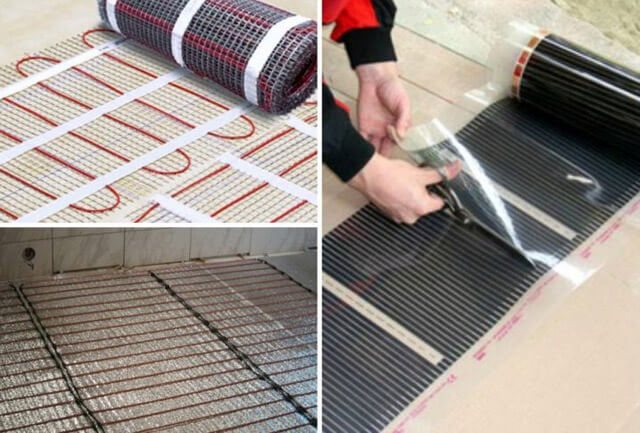

If the warm floor is to act as the main heating, then it is logical to consider a water system or a high-power heating cable.
Product quality should also be a priority. You should not blindly trust advertising and buy systems from previously unknown manufacturers. Your best bet is to rely on certified products that, if used correctly, can last for years.
- Similar posts
- What is National Comfort underfloor heating?
- How to install the underfloor heating film?
- How to install a warm floor on a wooden floor?
- How to connect a warm floor in an apartment?
- What are the characteristics of a warm floor Warmstad?
- How to install Energy underfloor heating?


